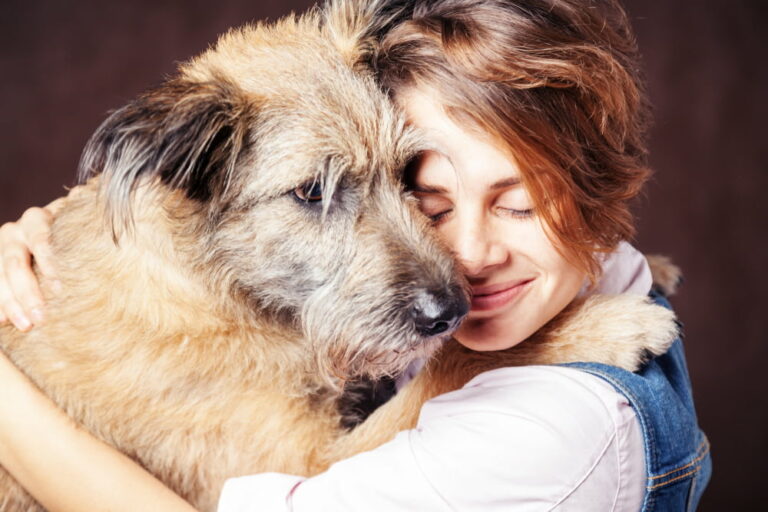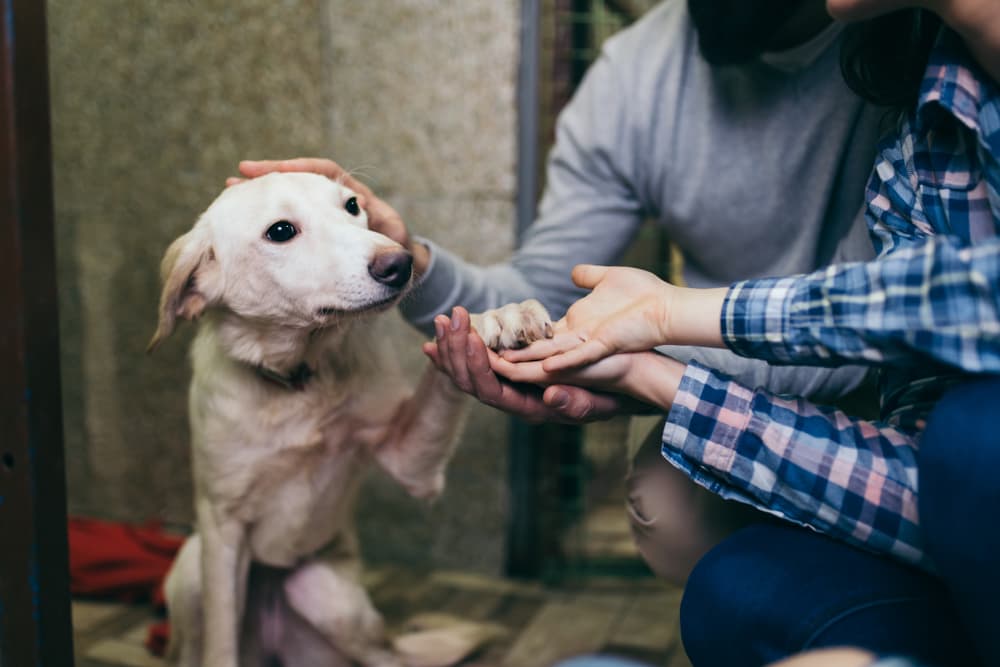Training a Rescue Dog: Everything You Need to Know

There’s nothing quite like the magic of bringing home a new rescue dog! Finding your best friend at the shelter or discovering him through a rescue organization not only helps a pup in need, it also fills the dog-shaped space in your heart and home in a way unlike any other.
Training a rescue dog will help to fast track your new relationship while your dog picks up important life skills. Not only does training give your dog an understanding of good manners and how to be a polite family member, it’s an easy way to cement your growing bond. And best of all? It’s fun!
Training a Rescue Dog: Why It’s Different Than Puppy Training
Training a puppy is a series of fun firsts. Everything about the process is new, and a pup is likely to be an eager (and excitable!) student with a short attention span. But the fact is, dogs of all ages enjoy learning throughout their lives (you can teach an old dog new tricks), and that includes your new-to-you adult rescue dog.
One of the perks of training an adult dog is the grown-up ability to focus for longer periods of time. Whereas pups do best with brief training sessions, an adult dog can handle full training sessions.
The best way to set your new rescue dog up for training success is to only use science-based positive reinforcement training. This type of training focuses on rewarding dogs for what they’re doing right rather than correcting them for mistakes. This leads to a happy, engaged student.
Any training that requires choke, prong, or e-collars is outdated and can actually damage your relationship, so stick with dog-friendly training.
How to Train a Rescue Dog: General Advice and Steps

Before you start your training routine with your new rescue dog, it’s helpful to keep the following things in mind:
Don’t Make Assumptions
When working with an adult rescue dog your best bet is to get rid of all assumptions you might have about your new friend. Your dog might be an adult that “should” know how to do certain things like going to the bathroom outside or walking politely on a leash, but that doesn’t mean that anyone ever taught him how. Until your rescue dog proves otherwise, it’s best to pretend that he’s a new pup that’s still learning how to be a part of your family and home.
Be Prepared for Personality Changes
It might be a surprise to realize that the dog you bring home won’t be the exact same dog you end up with, which means that your shy, sleepy rescue might turn into the life of the party after a few weeks of settling in. Adult rescues can be “shut down” either from challenges in their past, a lack of socialization, or a combination of the two.
Most rescue dogs go through a honeymoon/adjustment period when they move into a new home, so it’s likely that you won’t get to know your dog’s true personality until after he’s feeling settled and confident. This could be as brief as a few days to as long as a few months.
Learn to Read Your Dog’s Body Language
Finally, as you get ready to begin training it’s helpful to brush up on canine body language so you can understand exactly what your dog is saying to you. Misunderstandings about what a dog is communicating can delay the bonding process and make training more difficult. So, learn about the subtle and not-so-subtle things your dog is trying to say—from yawns to wags and everything in between!
House Training a Rescue Dog

Even though your new dog is an adult who “should” know where to potty, it’s important to note that a lack of housetraining is exactly what causes many dogs to end up in shelters. Keep in mind this training oversight is in no way your dog’s fault—more than likely they never had the opportunity to learn where to go.
Sadly, house-trained adult dogs that are forced to live in a shelter environment for extended periods often lose their good bathroom habits. And even rescue dogs that know where to go can have slip-ups in new households with different routines, or when their usual signals to go out might not be noticed. That’s why it’s best to pretend that your new-to-you dog needs to brush up on house training.
When house training a rescue dog use the same protocols you’d use with a puppy:
- Supervise your new dog at all times and crate or confine him if you can’t watch him.
- Use gates to keep your dog from sneaking away to eliminate in other rooms.
- Set up a consistent feeding schedule for predictable daily bathroom breaks.
- Give your dog a tasty treat immediately after he potties outside (don’t wait to come inside).
- Don’t punish accidents! A mistake in the house is usually due to a pet parent oversight.
Crate Training a Rescue Dog

Getting your new dog acclimated to a crate is a great way to help with potty training and will keep your furry new friend safe when you can’t watch him. Most dogs can learn to feel comfortable in a crate, but adult rescue dogs without crate experience might need more time to acclimate to it before being confined.
Here are some steps to make crate training your rescue dog a success:
Choose the Right Crate
Picking the right size crate will help keep your dog comfortable. The crate should be sized so that he can stand up, turn around, and lie down comfortably—but not much bigger than that.
Pick the Right Crate Location
Keep the crate in a part of your house that’s quiet but isn’t far away from the action. Don’t keep crates in out-of-the-way areas, like the basement or garage.
Make the Crate a Happy Place
Encourage your dog to get comfortable with the crate by feeding his meals inside it with the door open and give him goodies like treat-stuffed activity toys inside. After an acclimation period (it could take a few days or more) try closing the door for short periods while he’s inside enjoying a toy or bone and stay in the room with him.
Slowly Work Up to Leaving Your Dog Alone
Work up to leaving the room for short periods while your dog is crated, and if he seems content inside, attempt a short departure for twenty minutes. Gradually build up the duration that you’re away, but keep in mind that crating for a full workday isn’t healthy or fair to your dog.
Alternatives if Dogs Are Uncomfortable in Crates
Rescue dogs that are resistant to crate training might do better in a small safe space, like a bathroom or powder room. Pet proof the area by getting rid of potential chew targets like the trash, countertop items, and bathmats and use a gate across the open doorway instead of shutting the door. Leaving your dog with a treat-stuffed busy toy will keep him happily occupied while you’re away.
Leash Training a Rescue Dog

Many rescue dogs don’t understand how to walk politely on leash—either because they never had the opportunity to learn, or because they’re adjusting to a stressful new walking environment, like moving from a rural area to a city.
As with all dog training, the best way to train a rescue dog to walk on leash is with positive reinforcement training, the right type of equipment, and plenty of patience. Follow these tips and tricks to help your rescue dog learn how to walk on a leash:
Choose the Right Gear
A six-foot fixed length leash is the perfect length to give your dog enough freedom to eliminate and explore, but not enough room to be dangerous to him or others. Extendable leashes aren’t a good fit when working on leash manners as they can accidentally encourage pulling.
Reward the Right Behavior
The goal of leash training is helping your new dog understand that pulling makes the walk stop and keeping slack in the leash results in forward movement and treats! As you walk with your dog, feed him lots of small tasty treats in position near to your leg as a reward for keeping the leash loose. Your dog doesn’t have to be in a perfect heel position during the early stages, the only requirement is to keep the leash loose.
Stop Walking If Your Dog Begins Pulling
If something catches your dog’s attention and he starts to pull, stop walking. Most dogs aren’t used to this change of pace since pulling usually allows him to get where he wants to go! When your dog looks back at you praise him for his attention then reward him with a treat and continue walking, still giving him treats for a slack leash.
Consider a No-Pull Harness
In scenarios where the rescue dog is more powerful than the walker, or if the pulling is nonstop, it’s a good idea to use a no-pull harness. These harnesses are designed to reduce pulling with gentle pressure or by changing the fulcrum point of the leash thereby making it difficult for a dog to pull successfully. No-pull harnesses are a humane, dog-safe way to quickly manage leash pulling.
How to Train a Fearful Rescue Dog

While all rescue dogs require pet parent patience as they adjust, fearful rescue dogs need an extra slow and gentle approach.
Fearful dogs need more than just basic manners training. They’ll likely require help overcoming anxieties stemming from everyday life, like sounds or noises around the house or neighborhood, meeting people, or going to new places. A fearful dog should set the pace for all training, which will allow him to learn without pushing him outside his comfort zone.
Fearful dogs do well with classical conditioning, in which they learn to make a positive association to whatever it is that worries them. The goal is to pair treats with the frightening trigger to gradually change the dog’s perception of it. Working slowly to address the fear, using a variety of high value treats, and keeping enough distance from the trigger can all help to boost a nervous dog’s confidence.
Finally, remember to act as your nervous dog’s advocate. If someone wants to interact and your dog looks uncomfortable, ask for a pass. If your dog’s body language suggests that he’s worried, try to pinpoint the source of his stress.
The best thing you can do when training a fearful rescue dog is acknowledging and responding to him so that you build his confidence and tackle the world as a team.






